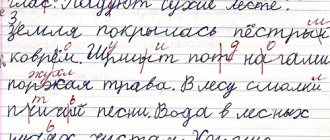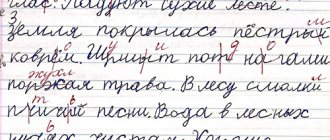Dysgraphia is a psychological deviation from the norm, characterized by a violation of the child’s written speech, not associated with ignorance of the rules of the Russian language. At the same time, the student is not able to write words, phrases, and texts correctly. He makes several non-standard, incomprehensible to most people, errors in one word.
The problem worries parents, since children with dysgraphia cannot study normally and complete tasks in the Russian language at the level of their peers. This often makes them outcasts and negatively affects their future lives.
Some parents, even teachers, don’t understand what’s going on: they scold the student for inattention, stubbornness, and lack of effort. In fact, the child needs help: and the sooner it is provided, the better.
To cope with writing disorders, it is important to diagnose them early. Timely identification of abnormalities will help overcome the disease, and will also give the child a chance to live a full life without problems and complexes.
What are the causes of dysgraphia?
The correct writing of words and the expression of one’s thoughts on paper largely depend on the correct formation of oral speech.
There are 2 groups of causes of dysgraphia:
- Diseases suffered at different stages of the development of the nervous system and brain. These include maternal illness during pregnancy, birth injuries, further serious infections and damage to vital organs.
- Social and psychological: communication with people who have pronunciation defects, learning several languages from early childhood (for example, in bilingual families), lack of correction of speech errors by parents.
These factors often lead to the formation of non-standard sound pronunciation and sound perception (phonemic hearing), and negatively affect the lexical, grammatical and coherent components of the child’s speech.
DYGRAPHIA
Writing is a kind of foreign language that a child must master within a year, think about it. Writing is the most complex type of educational activity; all parts of the child’s brain are involved in its formation. That is, the psychophysiological basis of writing is the interaction of the work of various analyzers - speech motor, auditory, visual, manual motor. When writing, the interaction of such mental processes as thinking, memory, attention, imagination, external and internal speech occurs. Learning to write is a process of harmonizing all of these factors.
Dysgraphia is the inability (or difficulty) to master writing with normal intellectual development. In most cases, dyslexia and dysgraphia occur simultaneously in children, although in some they can occur separately.
Causes of dysgraphia
The writing process goes through several stages: the child “sees” the future spelling of the word. However, in children with optical dysgraphia, a persistent defect in the near space, a kind of “window,” was discovered. The space outside the “window” is mirrored in the form of reverse perspective. That is why, when a letter or number falls into this window, the child writes it like that - upside down. There are errors in the outline of letters, spatial orientation on a sheet of paper, or line. At the same time, internal pronunciation (inner speech) is a frequent, but not obligatory, stage of learning to read. The proof is learning to read according to Glenn Doman, when a child remembers a whole word as a hieroglyph.
However, it is much more difficult for a child to write a word than to read it. Difficulties in mastering writing are also due to the fact that either each of the processes necessary to write a word, or some part of them in a child, is still imperfect.
Work on the prevention of dysgraphia should begin in preschool age. Even then, children necessarily already have diagnostic markers and prerequisites for the future development of dysgraphia. Remember, dysgraphia will not disappear on its own, it needs to be corrected and corrected . (More details here: How to help your child prepare for school .)
Methods for identifying dysgraphia
Identification of dysgraphia is a complex process, which is based on solving the following problems:
- Distinguish an illness from ignorance of the rules of spelling words.
- Distinguish between this type of disorder and pathologies of the organs of vision, hearing, and ENT organs.
- Determine the form of the disease.
If there is a suspicion that a child has a pathology, you should consult with specialists:
- ophthalmologist - will see eye diseases and cerebral circulation disorders;
- otolaryngologist – examines for diseases of the throat, ears and nose;
- the dentist will see defects in the structure of the teeth, which may interfere with the correct pronunciation of words and indirectly contribute to their illiterate spelling;
- neurologist - will determine the state of the central nervous system and the problems existing in this area;
- speech therapist - will identify the presence of oral speech defects and their relationship with errors in writing, determine the type of dysgraphia.
The main stages of diagnosing dysgraphia are:
- Research of written works.
- Study of the patient’s physical, mental, speech development, condition of the organs of vision and hearing.
- Examination of the articular apparatus, manual and speech motor skills, determination of the dominant hand.
- Study of the level of sound perception, sound pronunciation, vocabulary of the child, knowledge and use of lexical and grammatical basics.
- Conducting a writing test.
Written language analysis involves identifying the disorder by presenting the child with various written tasks, after which a verdict is made. Types of written tasks for diagnosing dysgraphia: copying from handwritten and printed texts, describing pictures, dictations, tests.
In preschool children, the risk of subsequent problems with writing is identified by the quality of their drawings. Potential dysgraphics aged 3-6 years are drawn reluctantly, with uneven lines, abruptly, and unclearly. This is often due to undeveloped finger muscles and poorly developed hand motor skills.
Diagnosis and correction of optical dysgraphia and dyslexia
Olga Kretova
Diagnosis and correction of optical dysgraphia and dyslexia
“By fighting for good handwriting and a good notebook, we are essentially fighting for students’ literacy” S. P. Redozubov
Teaching writing in the light of optimizing the educational process of primary schoolchildren
The issue of preparing preschoolers to master writing is part of the problem of preparing for school, which is becoming more and more relevant every year.
Today, the task of teaching preschoolers to write does not have a clear solution. There are both opponents and supporters of the inclusion of writing in the lives of older preschoolers. There is an opinion about the lack of readiness of the child’s body for this type of activity, the high probability of a deterioration in his health, and the teachers’ ignorance of methods for teaching writing. Others believe that many difficulties in elementary school can be avoided if preparatory work is carried out in a timely manner. This opinion is shared by most parents.
Research has established that literacy and calligraphy are interconnected. For example, with large and sweeping handwriting, children learn spelling patterns worse, since the child’s gaze experiences tension when “covering” a word or phrase. The appearance of errors is often caused by unclear or incorrect images of letters and their connections, careless writing of words, and text in general. Observations indicate that the desire to write beautifully, clearly, and quickly contributes to improving literacy (L. Ya Zheltkovskaya, E. N. Sokolova).
I, an adult and experienced (thanks to the unforgettable Anastasia Ivanovna, a literate person with beautiful handwriting, I still remember how long it took me to earn the right to write in a notebook with a wide line.
Optical dysgraphia and dyslexia
Reading and writing disorders (dyslexia and dysgraphia) are the most common forms of speech pathology in younger preschoolers. Writing and reading disorders have the same etiology and similar mechanisms.
For differential diagnosis, it is necessary to know the symptoms and mechanism of optical dyslexia and dysgraphia.
Dyslexia is a partial disorder of the reading process, manifested in persistent and repeated reading errors due to the immaturity of the HMF involved in the process. Optical dyslexia manifests itself in substitutions and mixtures of graphically similar letters. Most often mixed:
• letters that differ in only one element (V-Z, D-L. b-b)
• letters consisting of identical elements, but differently located in space (T-G, R-L, X-K, P-N-I).
With this type of dyslexia, mirror reading may occur.
Optical dyslexia is associated with immaturity of visual-spatial functions:
• Visual gnosis:
— Orientation in the body and in the surrounding space
- Spatial ideas (that is, ideas about the shape and size of objects and their location in space in relation to each other). Their recognition and reproduction in drawings and reflected speech
— Visual-spatial orientation (study of constructive praxis, study of graphic activity)
— Understanding of complex logical and grammatical structures
• Visual analysis and synthesis
And:
• The size of the lateral vision zone, which determines the number of letters and words that a child can simultaneously perceive. A narrow area of lateral vision prevents fast and correct reading
• Lack of attention, that is, the ability to select the necessary information and discard unnecessary information, namely:
1. Insufficient concentration and stability
2. Insufficient selectivity
3. Insufficient randomness
4. Insufficient volume and distribution
• Low level of self-control and self-regulation, which prevents the child from managing his own activities. It is difficult for him to subordinate his desires to requirements, to concentrate attention, to remember information, to make a strong-willed effort to perform interesting or monotonous tasks
• Individual typological characteristics
Dysgraphia is a partial disorder of the writing process, manifested in persistent, repeated errors caused by the immaturity of the HMF; the causes of optical dysgraphia are the same as with a similar form of dyslexia.
Optical dysgraphia is divided into literal, which manifests itself in difficulties in reproducing even isolated letters, and verbal, in which the reproduction of isolated letters is preserved, but when writing words there are distortions, substitutions, mixing of graphically similar letters, and contextual influences of neighboring letters on the reproduction of the visual image of the letter.
Very close to optical is one of the varieties of dysgraphia - motor (or kinetic, associated with a disruption in the connection of motor images of words with their sound or visual images; most often these dysgraphias complement each other or can exist independently.
Identification of the prerequisites for optical dysgraphia and dyslexia in older preschoolers (stage 1)
The easiest way to determine the formation of visual-spatial representations is to check their understanding of the meanings of prepositions denoting the location of objects in space in relation to each other
1. Take 6 pencils and one book, arrange them using the prepositions ON, UNDER, IN, BEHIND, ABOUT, and hold the last pencil ABOVE the book. After this, consistently ask questions: “Show me which pencil is under the book?” etc.
2. With the same spatial arrangement of the book and pencils, change the nature of the questions and ask the child to take a pencil FROM, BEHIND, FROM UNDER, WITH, FROM the book. If there is difficulty in the first two tasks, suggest a third one.
3. An adult and a child each have a book and a pencil. Place your pencil on the book and ask your child to do the same without giving the child an excuse. Do several tests with different prepositions. If the task is not completed, the very spatial arrangement of objects and the very meaning of using the corresponding prepositions in speech are unclear.
4. Correct orientation in the right and left sides of space.
Stage 2 of the study (preparatory group, beginning of schooling)
1. Features of fine motor skills
1. Determination of the leading hand
2. Study of finger praxis (optical-kinesthetic organization of movements). The child is asked to connect 1-2 fingers in the form of a ring, extend 2 and 3 fingers, 2-5 (the rest are bent)
3. Dynamic organization of finger movements. Fingering (“fingers greet”, first at a slow, then at a fast pace. “Playing the piano.” Alternately touching the fingers to the table: 1,2,3,4,5;5,4,3,2,1-right , left, two hands
Study of visuospatial functions (stage 2)
1. The state of the child’s biological vision
2. Immediate state of visuospatial functions
• Determination of the dominant hand (test for interlacing fingers, test for clapping, test “Napoleon pose”, study of the width of the nails of the little finger)
• Determination of the leading leg (it is suggested to stand on one knee, do a small long jump)
• Determination of the dominant eye (it is suggested to look into a hole, into a kaleidoscope, into the hole of a tube)
• Determination of the leading ear (it is suggested to listen to the noise in the corridor, putting your ear to the door, to the ticking of a clock, to the rustling inside a shell)
• Orientation in the surrounding space (what is to your left, what is to your right, in front, behind, above, below)
• Performing Head tests (“show your left eye with your right hand”, “show the right and left parts of the body of the person sitting opposite you”, etc.).
• Compiling a picture cut into 5,6,7,8 parts
• Designing figures from sticks according to a model, according to an idea
3. State of visual-motor functions
Study of the reading process (stage 2)
• Determine the nature of reading syllables (simple and with a combination of consonants)
• Words (monosyllabic, bisyllabic, polysyllabic, 9simple and complex in sound-syllable structure)
• Sentences (simple, common, common, complex, complex)
• Text
• Determine reading speed
• Indicate the reading method (letter-by-letter, syllable-by-syllable, word-phrase)
Stage 3. Neuropsychological approach
Graphic writing skills belong to human sensorimotor skills and are associated with educational activities and serve the process of writing. They are not formed in isolation, but together with reading, spelling, and the development of written speech. At the highest level of development of a letter, its orthographic and calligraphic sides are not realized, a person’s main attention is directed to expressing his thoughts, the writing process is carried out easily and quickly, as if involuntarily. A number of authors, tracing writing impairments (A.R. Luria and others) with damage to individual areas of the cerebral cortex, note their specific functions, manifested in different types of writing. The occipital region is closely connected with the visual organization of the writing process; its defeat leads to spatial disturbances. The parietal region is of great importance for ensuring subtle and clear movements; maintaining alternation in the desired sequence of letters and maintaining the motor image of a letter and a word is associated with the premotor area of the cortex. By classifying optical and motor dysgraphia into a special group, we nevertheless separate cause and effect. The leading symptom of motor dysgraphia is difficulty in finding the necessary movements to write the elements of a particular letter. Children lose their lines, write sloppily, the letters turn out to be different in size, and it takes a long time to develop individual handwriting. The optical form is associated with a disorder of optical-spatial representations. Differentiation of the causes of writing and reading disorders will be made possible by a more in-depth diagnosis, which contains stages, criteria, scores for productive activities, and a list of errors that are not related to productivity. The result obtained in points is assessed and interpreted by a neuropsychologist, neurologist and speech therapist
Very rarely we observe only optical dyslexia and (or) dysgraphia in a child. As a rule, such disorders “like” to be combined with each other, taking other types of dysgraphia or dyslexia into “company”, since the pathological processes that feed these conditions often have a common nature, or mutually complement each other.
Testing to determine dysgraphia in a child
Testing is considered an effective method for identifying writing disorders in primary school students. Tests can be compiled general or for specific types of dysgraphia.
They allow you to learn the following child skills:
- perceive words, phrases, sentences by ear and write them down;
- divide words into syllables and sentences into words;
- correctly identify sounds;
- connect words by gender, number, case;
- make up words and phrases;
Test execution rules:
- Compliance with the established sequence of test tasks.
- If there are any missed items, you need to return to them after completing the test.
Example of test tasks:
- Make up a phrase using the word in brackets in the correct form:
a) buy a (guinea)__________ pig; b) take (sticky)__________dough; c) get a (solid)_________A.
- Can you form a word from the given letters?
a) KOSHLA; b) CHEBUKIN; c) MONLEY.
- Cross out the syllable indicated in brackets on the line:
a) (pi) neither ip pi nor il pi ip; b) (shu) shu shu ush ush tsu do shu schu; c) (ah) oh cool as much oh ah ah as much as oh ah cool.
Often, tests to determine dysgraphia include dictations, as well as analysis of visual aids (pictures with letters, syllables, drawings).
The conclusion is made not only based on the test results, but also on the speed at which the student completes tasks. Children with writing impairments complete each block slowly, and the design of the work usually contains numerous crossed-outs.
School for overcoming dysgraphia - video course for speech therapists
Definition: dysgraphia is a partial disorder of the writing process, manifested in persistent, repeated errors caused by the immaturity of the higher mental functions involved in the writing process R. I. Lalaeva (1997)
We present to you a video course covering the issues of diagnosis and correction of dysgraphia . The lectures will be useful for current and aspiring speech therapists who encounter dysgraphics in their work.
The video course program includes 4 topics:
Video lecture No. 1
Topic: Characteristics of the process of children mastering the skill of writing according to the rules of graphics. Comprehensive diagnosis of dysgraphia in primary schoolchildren.
In a programme:
- Study of early anamnesis.
- Study of the psychological prerequisites for the formation of oral and written speech.
- Requirements for diagnostic tools. Study of children's psychophysiological readiness to master speech activity.
- Determination of motor maturity. Kinetics survey. Kinesthesia examination.
- Examination of visuospatial functions.
- Diagnostic methods for studying the speech and language abilities of schoolchildren.
- Examination of the sound-pronunciation aspect of speech, phonemic processes, the state of the dictionary and the grammatical structure of the child’s speech.
Video lecture No. 2
Topic: Identification, prevention and correction of optomotor dysgraphia in primary schoolchildren.
In a programme:
- Teaching calligraphy to primary schoolchildren with a predisposition to writing disorders.
- Preparatory stage (development and correction of motor skills; development of motor sensations; development of the ability to feel the relationship between hand movements and the size of an object.
- Development of the ability to sense and control the movement of the hand to the right along the line); the main stage of learning calligraphy.
Video lecture No. 3
Topic: Articulatory-acoustic dysgraphia: prevention and elimination of errors in writing caused by the peculiarity of the sound-pronunciation side of speech.
In a programme:
- Sound pronunciation disorders and their impact on the development of written speech skills.
- Classification of sound pronunciation disorders (dyslalia and dysarthria) according to etiopathogenetic criteria, by the volume of sound pronunciation disorders, and by symptoms. Anomalies in the structure of the articulatory apparatus, their role in the occurrence of sound pronunciation disorders.
- Diagnosis of sound pronunciation disorders. Correlation of disorders of the phonetic and phonemic systems.
- The role of the teacher in organizing and conducting correctional work aimed at eliminating violations of the sound-pronunciation side of speech.
- Inclusion in the system of literacy classes for junior schoolchildren of corrective measures aimed at preventing and eliminating manifestations of articulatory-acoustic dysgraphia in written works.
Video lecture No. 4
Improving the skills of phonemic perception, language analysis and synthesis in writing disorders. Video lecture No. 4
In a programme:
- Dysgraphia due to impaired phoneme recognition.
- Main mistakes and ways to correct them. Confusion of the concepts “sound” and “letter”. Errors in sound characteristics.
- Mixing oppositional sounds and corresponding letters.
- Teaching phonemic analysis in literacy classes for at-risk elementary school children.
- Speech sounds. Classification of sounds according to the method of pronunciation. Vowel sounds.
- Mastering syllabic analysis. Syllable analysis based on the number of vowel sounds in a word.
Duration of each video lecture: 120 minutes.
Bonus: Dysgraphia. Work album in 3 parts.
The exercise album is included in the set of manuals for the prevention and correction of dysgraphia in preschoolers and primary schoolchildren. Using the materials from the kit will allow the speech therapist to carry out preventive and effective correctional work throughout the year.
The set of manuals can be used by speech therapists of mass and correctional schools, and students of defectology departments. For propaedeutic purposes, it can be used by speech therapists and teachers of correctional groups in kindergartens.
Volume: 3 albums of 90 pages.
Age: for children 1+.
- After purchase, access to the course opens forever.
- Upon completion of the marathon, you will be issued a certificate for 8 academic hours!
- Each video lecture will include a presentation that you can use in your future work!
- Watch video lectures wherever and whenever it is convenient for you!
- The material is available on all electronic media!
- The certificate will be available in your personal account immediately after purchasing the course!
Diagnosis of types of dysgraphia
Depending on the type of mistakes that a child diagnosed with dysgraphia most often makes, there are 5 types:
- ungrammatical;
- optical;
- articular-acoustic;
- acoustic;
- dysgraphia with disorder of language analysis and synthesis.
Diagnosis of each type of writing disorder differs in a specific technique and has its own characteristics.
Agrammatic dysgraphia
Agrammatic dysgraphia is associated with a disorder in understanding the connection between different parts of a sentence and their dependence on each other. The student makes mistakes when changing words by gender, number, cases (blue dress, kind girl), using verbs in different forms, spatial prepositions (on, under, for, in).
Identification by a professional of agrammatic writing disorder in children involves the use of the following methods: writing a dictation, written and oral test tasks using visual aids.
In the dictation of a child with agrammatic disorders, numerous errors and corrections will be found related to the endings of adjectives, nouns, the spelling of prefix verbs, omissions of words and phrases.
Tests for agrammatic dysgraphics include tasks to check understanding:
- Differences between singular and plural nouns, adjectives and verbs:
Write the form of using the word in the indicated quantity: one mug, two_______, seven______.
- Case and gender endings of adjectives:
Use the word in brackets in the correct form: eat a (juicy) pear.
- Verb prefix changes:
Put the verb in brackets in the required past tense form: he (go) from the entrance, he (go) into the entrance
- Uses of perfect and imperfect verbs:
Use the verb in the correct form: Yesterday after a walk he came home and (eat) two plates of potatoes with herring. Now Sergey (is) borscht in the kitchen.
- Definitions of verb gender in the past tense:
Insert verb in past tense: dog (to run), cat (to run)
- Collateral relations:
Use the verb in active and passive forms: the boy (to wash) himself, dad (to wash) the boy.
- Prepositions that express the spatial relationships of things:
Insert prepositions: find a thing__on the table, put slippers on__the bed, buy dill__at the market.
- The relationship of objects and phenomena - what happened before, what after; who was in front, who was behind:
Answer the question: The giraffe stood behind the elephant, but in front of the hippopotamus. Who was the first?
Oral tests usually use pictures and cards for ease of use and a more informed diagnosis. Here, tasks are given for the child to compose and write down phrases and sentences with the help of visual aids.
Children without written language impairments will write such a test without difficulty, making a minimum of mistakes. Children with agrammatic dysgraphia perform no more than 60-70% of tasks correctly.
Dysgraphia with impairment of language analysis and synthesis
This type of dysgraphia is expressed in a violation of the perception of a word as a set of syllables, and a sentence as a set of words and phrases. Children with this deviation rearrange, skip letters (consonants when they are combined, vowels), even whole words, and write 2 letters in a row. Diagnosis is carried out on the basis of dictations and tests.
A dictation for a schoolchild with a violation of language analysis and synthesis will show omissions of letters, phrases, spelling them together, and rearrangement of letters and syllables. Self-test will only partially help in this case.
This type of dysgraphia is also determined by conducting tests. They use tasks to compose words from letters, sentences from words, and calculate the number of syllables in a word.
Example test:
- Make a word from letters:
a) BLAOKO; b) NOKO; c) SHORGOK.
- Make a word from syllables:
a) RE KA TA; b) RAT PI; c) STRUKA LA.
- Determine the number of letters:
a) river; b) root; c) club.
- Count the number of syllables:
a) PYRAMID; b) STRAW c) PIRATE.
- Make a sentence from the words:
a) went to Masha’s garden; b) a dog is gnawing on a bone; c) the cat climbed the tree.
Articular-acoustic dysgraphia
With this form of dysgraphia, the child pronounces certain words incorrectly, which causes errors in their spelling (confuses the letters r-l, k-g, zh-z, sh-s, sh-f). Testing methods, dictations and oral communication with a speech therapist will help determine articulation disorders.
Dictation and test tasks will reveal confusion in the writing of those letters that children most often do not pronounce.
Test for determining articular writing disorders:
- Insert one of the following letters:
a) t(l,r)acto(r,l), (h,g)y(g,h)el; b) (g,k)oster, (W,s)a (s,w)a; c) (ts,h)ek, (s,ts)aplya
- Insert the required letter:
a) Mom is cooking delicious food; b) The bee killed him; c) The bicycle was driving along the highway; d) Scout on horseback _four knights; e) _obaka uku_ila _arya.
Communication with a speech therapist will show whether there are errors in the pronunciation of sounds and how much they affect the quality of writing. If a student pronounces a sound incorrectly, he may write it with errors.
Acoustic dysgraphia
Children with acoustic writing disorder do not have problems with pronunciation, but sound perception is impaired. They confuse letters that sound similar. For example, instead of voiceless consonants, voiced ones are used (p-b, k-g, t-d), instead of vowels, 2 rows are used with a soft sign, one hissing consonant is replaced with another (f-s, s-sh), this does not indicate the softness of the sound.
This type of writing disorder is most often determined using dictation.
Dictation tasks:
- They admired the sunset (yew, yew).
- He was supposed to arrive at eleven o'clock (t-d)
- Sasha ate one dryer and put the rest in the closet (sssh).
- A cold drop fell on my palm (yah, yah).
- He took a brown bottle and threw it into a full bucket (replacing row 2 vowels).
- The priest fell and hurt his forehead (b-p).
- Sparrows flew into the fence(s)
An acoustic dysgraphic person will write the words incorrectly in such a dictation, replacing the letters in them with one or more similar-sounding ones. Based on such tasks, you can create tests with missing letters.
Optical dysgraphia
Children with optical dysgraphia confuse letters with those that are visually similar to them (Ш-Ш, Х-ж, Ц-Ш, А-Д). There are many methods to detect a problem: dictation along lines, text dictation, copying from a sample, tests, copying from printed and handwritten texts.
Line dictation is carried out as follows: the adult controls the movements of the child’s pencil using verbal instructions. Dictation example:
Place a dot in the middle of the sheet, draw a line one cell up, now 2 cells to the right and another 5 cells down. Draw a circle here and draw a line down.
You can include any instructions that can determine the student’s level of attentiveness. It will be difficult for an optical dysgraphic person to concentrate attention and complete such a task accurately.
Copying an object from a visual aid helps to identify inattention in copying images. Here you can show the children, for example, a simple drawing of a house or several geometric shapes.
Text assignments identify specific writing errors that are most often made by the student. When copying from printed or handwritten text, a child with optical impairments will write letters incorrectly, replacing them with graphically similar ones.
It is not difficult to determine optical writing disorders using tests .
Examples of test tasks:
- Insert missing letters:
a) puree_, _bed, _losip_d; b) _uka, _promise, _epot; c) pe_e, _orog, _za_ya.
- Cross out a letter that repeats once from a line:
a) sch w sch p s w sch p w; b) o e z v o v e a e a v; c) x f x y j k x f y x f
- Cross out the syllable after the dash in the line:
a) hee uh zhu hu uh uk hu ku - uh; b) ne ep op he is not ep pon but he is he; c) ze ve vo ov ev zev vez ze av – ze.
An optical dysgraphic person will not be able to choose the correct option from those proposed in each block. He will confuse similar letters.
Dysgraphia is a serious deviation from the norm. It can only be eliminated with the help of coordinated actions of the child, teachers, parents, speech therapist and neurologist. In order not to start a violation, you need to diagnose it in a timely manner.
Each type of writing disorder has its own ways of detecting deviations. With their help, it is easy to identify dysgraphia and determine its type. After diagnosis, corrective measures can begin.
Related posts:
- History, signs and symptoms of dysgraphia Symptoms of dysgraphia in children and methods of overcoming it depend on ...
- Means for the prevention of dysgraphia in preschoolers with general speech underdevelopment Prevention of dysgraphia in preschoolers with OSD - means of prevention, games,…
- Organization of an experimental study of dysgraphia From the experience of studying dysgraphia - diagnosis of dysgraphia at the ascertaining stage...
- The psychophysiological structure of writing and the prerequisites for its formation Written speech is the structure of writing and the prerequisites for the formation of writing skills….
Examination of children with dysgraphia
What is this research?
At the initial appointment, the speech therapist collects anamnestic data. It is necessary to find out what circumstances could have influenced the delay in speech development: pathologies of pregnancy, childbirth, early age of the child. After this, a speech history is collected: when humming, babbling, and the first words and phrases appeared. It is necessary to find out whether the child worked with a speech therapist, and with what results.
An important point of the examination is the collection of data on the state of hearing, vision, general and articulatory motor skills, and the characteristics of the child’s cognitive activity. The state of hearing is checked by loud and whispered speech at a distance of 6 m. The state of healthy perception is checked mainly on tasks of recognizing and naming colors.
When examining general motor skills, the ability to hold a given position for a certain time, smoothness of movements, and absence of tension are determined. The result of the fine motor examination is very important. Each exercise is first explained and shown to the child, and then asked to complete it.
The following exercises may be suggested for examination:
- sequentially touching the thumb of the right (and then the left) hand to the remaining fingers;
- simultaneous raising of the fingers of the right (left) hand from the table;
- sequentially lifting fingers from the table, starting with the thumb;
- simultaneous change in the position of the hands (one hand with fingers joined together, the second with fingers apart - then vice versa).
When examining the state of articulatory motor skills, the structural features of the parts of the articulatory apparatus are taken into account: lips, teeth, hard and soft palate, tongue, sublingual ligament. After this, the child is asked to repeat the articulation exercises that the speech therapist shows. When assessing motor skills, the accuracy and volume of movements performed, changes in the tone of the articulatory apparatus, and the ability to maintain articulatory position are taken into account.
After examining the condition of the articulatory apparatus, the speech therapist checks the student’s oral speech. The pronunciation of vowels and consonants is checked, and special attention is paid to substitutions and confusion of sounds. Attention is paid to whether the child creates the syllabic structure of the word and whether he uses stress correctly.
When examining the state of phonemic perception and sound analysis, the child is offered the following tasks:
- determine the number and sequence of sounds in words;
- determine the place of a given sound in different words;
- name common sounds in different words;
- name distinct sounds in similar words;
- choose words for a given sound;
- choose pictures for a given sound.
When examining the lexico-grammatical system of speech, the volume of active and passive vocabulary, the predominantly used parts of speech, and the correct use of words according to their meanings are taken into account. The structure of sentences that the child uses (simple, common, complex), as well as the correctness of the construction of statements, is analyzed. Specially selected tasks make it possible to identify agrammatism in the agreement of words in gender, number, and case.
A mandatory element of the examination is to check the student’s coherent speech. The child is offered a series of drawings or a complex plot drawing, based on which he must compose a short story. As a rule, this task causes the greatest difficulties for dysgraphic children. They simply make up a few simple common and uncommon sentences about the content of the drawings, but cannot connect them with each other so that a complete story emerges.
After examining independent statements, the student is asked to read letters, syllables and words of different syllabic structures. Attention is paid to the type of errors (continuous or letter-by-letter reading, omissions, rearrangements, letter substitutions, stress). Then the child is asked to read and retell a short text. This takes into account reading technique (fast, slow, inexpressive, with errors) and reading comprehension.
An examination of the state of the student’s mental processes is carried out both at the initial appointment and during correctional classes. Children are offered games to test and develop memory, attention, logical thinking, and visual-spatial concepts.
Based on the results of a comprehensive examination of the speech condition, correctional work is carried out to overcome dysgraphia in the child.









